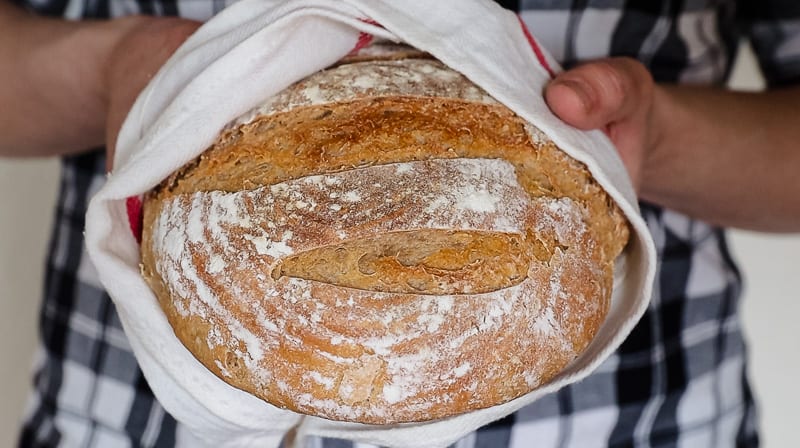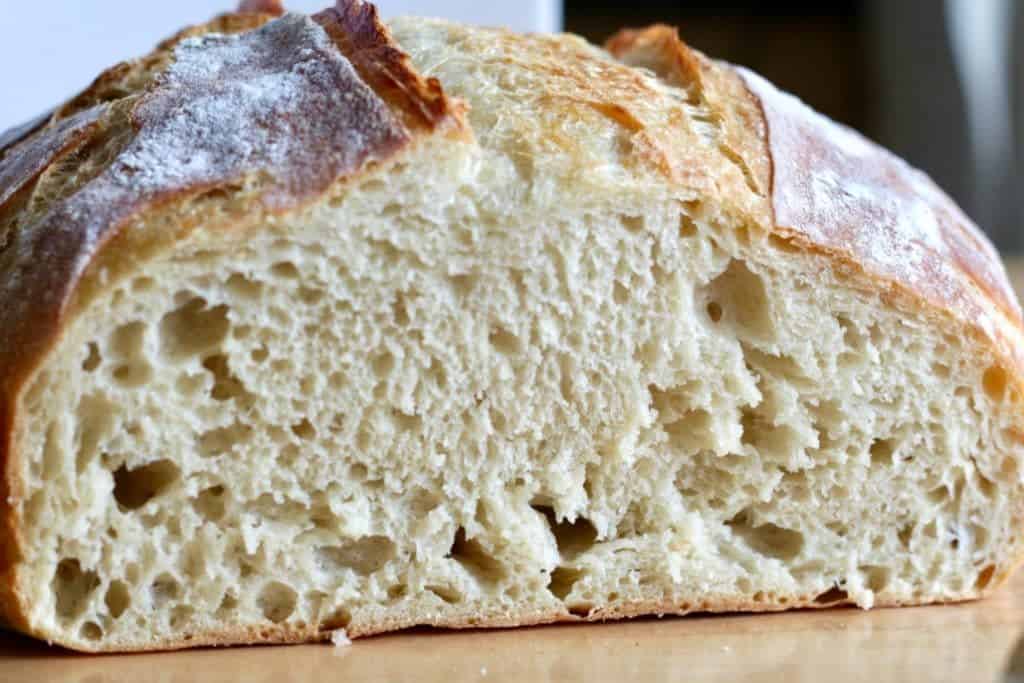Embark on a culinary adventure with our comprehensive guide to crafting the perfect sourdough bread. Whether you’re a seasoned baker or a novice eager to explore the world of fermentation, this recipe will empower you to create a delectable masterpiece.
Sourdough bread, with its tangy flavor and artisanal charm, has captivated bread enthusiasts for centuries. Join us as we unravel the secrets of this time-honored tradition, providing you with the knowledge and techniques to bake a loaf that will impress your taste buds and elevate your culinary repertoire.
Ingredients and Equipment
Sourdough bread, with its tangy flavor and rustic charm, is a staple in many households. Crafting this delightful treat at home is surprisingly straightforward, requiring only a few basic ingredients and some essential equipment.
Ingredients
The core ingredients for sourdough bread are simple:
- Flour: High-quality bread flour or a combination of bread flour and all-purpose flour provides the structure and gluten formation for a chewy texture.
- Water: The hydration level of the dough determines its consistency and crust. Filtered or spring water is recommended for optimal results.
- Salt: A touch of salt enhances the flavor and balances the sourness.
- Sourdough Starter: The heart of sourdough bread, this fermented mixture of flour and water introduces the tangy sourdough culture.
Equipment
To create sourdough bread, a few essential tools are required:
- Mixing Bowls: A large bowl for mixing the dough and a smaller bowl for the sourdough starter.
- Measuring Cups and Spoons: For accurate ingredient measurement.
- Baking Sheet: A well-seasoned baking sheet or Dutch oven for baking the bread.
- Lame or Scoring Knife: To score the dough before baking, allowing it to expand evenly.
- Thermometer (Optional): To ensure the dough reaches the optimal temperature for fermentation.
Starter Culture
A sourdough starter is a symbiotic culture of bacteria and yeast that is used to leaven bread. It is made by mixing flour and water and allowing it to ferment for several days. The bacteria and yeast in the starter consume the sugars in the flour and produce lactic acid and carbon dioxide.
The lactic acid gives sourdough bread its characteristic tangy flavor, and the carbon dioxide causes the bread to rise.
Creating and Maintaining a Sourdough Starter
To create a sourdough starter, you will need:
- 1 cup whole wheat flour
- 1/2 cup water
- A clean glass jar or container
Instructions:
- In a clean glass jar or container, whisk together the flour and water.
- Cover the jar with a cheesecloth or paper towel and secure it with a rubber band.
- Place the jar in a warm place (75-80 degrees Fahrenheit) for 24 hours.
- After 24 hours, discard half of the starter and feed it with 1/2 cup whole wheat flour and 1/4 cup water.
- Repeat steps 3 and 4 for 5-7 days, or until the starter is bubbly and active.
Once your starter is active, you can store it in the refrigerator for up to 2 weeks. To use the starter, remove it from the refrigerator and feed it with 1/2 cup whole wheat flour and 1/4 cup water 12 hours before you plan to use it.
Troubleshooting Common Issues with Sourdough Starters
If your sourdough starter is not bubbly and active, there are a few things you can try:
- *Make sure the starter is warm enough. The ideal temperature for a sourdough starter is 75-80 degrees Fahrenheit. If the starter is too cold, the bacteria and yeast will not be active.
- *Feed the starter more often. If the starter is not fed enough, the bacteria and yeast will not have enough food to grow. Feed the starter once or twice a day until it is bubbly and active.
- *Use a different type of flour. Some flours are better for sourdough starters than others. Whole wheat flour is a good choice because it contains more nutrients for the bacteria and yeast.
- *Be patient. It can take several days or even weeks for a sourdough starter to become active. Don’t give up if your starter is not bubbly and active right away.
Mixing and Kneading
The process of mixing and kneading the sourdough ingredients is crucial for developing the bread’s flavor, texture, and structure.
Mixing combines all the ingredients to form a dough, while kneading develops the gluten network that gives bread its elasticity and chewiness.
Hand Kneading Techniques
- Place the dough on a lightly floured surface. Use your hands to fold the dough over itself, pressing down with the heels of your hands to stretch and strengthen the gluten strands.
- Knead for 5-10 minutes, or until the dough becomes smooth, elastic, and slightly tacky to the touch.
- Use a dough scraper to clean the surface and prevent sticking. If the dough becomes too sticky, add a little more flour, but be careful not to overwork it.
Fermentation and Proofing

Fermentation is a crucial step in sourdough bread making. It is a process in which naturally occurring yeast and bacteria in the sourdough starter consume the sugars in the flour, producing carbon dioxide and lactic acid. The carbon dioxide creates bubbles in the dough, giving it its characteristic rise, while the lactic acid contributes to the bread’s distinctive tangy flavor.The
optimal conditions for fermentation are a warm temperature (around 75-80°F) and a humid environment. The dough should be allowed to ferment for 12-18 hours, or until it has doubled in size and has a slightly sour aroma.
Proofing
Once the dough has fermented, it is ready for proofing. Proofing is the final rise of the dough before baking. The dough should be placed in a warm, humid environment for 1-2 hours, or until it has almost doubled in size.
This final rise helps to develop the bread’s flavor and texture.To determine if the dough is ready to bake, gently poke it with your finger. If the indentation springs back slowly, the dough is ready. If the indentation remains, the dough needs more time to proof.
Baking and Cooling
Once your dough has risen and proofed, it’s time to bake and cool your sourdough bread. Baking sourdough bread requires specific techniques to achieve the desired crust and texture.
The optimal oven temperature for sourdough bread is between 450-480°F (230-250°C). This high heat creates a steamy environment in the oven, which helps the bread to develop a crispy crust and a chewy interior.
Creating Steam
Steam is crucial during the baking process, as it helps the bread to rise and develop a crispy crust. To create steam, you can place a baking stone or Dutch oven in the oven and preheat it along with the oven.
Once the oven is hot, pour 1 cup of water into the baking stone or Dutch oven and quickly close the door to trap the steam.
Cooling
After baking, it’s important to cool the bread properly to ensure a crispy crust and soft interior. Let the bread cool on a wire rack for at least 30 minutes before slicing and serving.
Troubleshooting
Sourdough bread-making can occasionally encounter challenges. Understanding common problems and their solutions will help you achieve consistent and delicious results.
Dense bread, gummy texture, and excessive sourness are common issues. Let’s explore the causes and remedies for each.
Dense Bread
- Underproofing: Ensure the dough has risen sufficiently before baking. Allow it to proof in a warm place for longer.
- Overkneading: Excessive kneading can develop the gluten too much, resulting in a tough texture. Knead only until the dough comes together.
- Insufficient hydration: The dough should be adequately hydrated to create a light and airy texture. Add more water if the dough is too dry.
Gummy Texture
- Underbaking: Ensure the bread is baked thoroughly. Insert a toothpick into the center; it should come out clean.
- Overproofing: Excessive proofing can weaken the dough’s structure, leading to a gummy texture. Proof the dough for the recommended time.
- Stale bread: Sourdough bread can become gummy if stored improperly. Keep it in an airtight container at room temperature.
Excessive Sourness
- Overfermentation: The longer the dough ferments, the more sour it becomes. Control the fermentation time to achieve the desired sourness.
- Active starter: Use a strong and active starter to ensure the dough rises properly. Refresh your starter regularly.
- Warm temperature: Fermentation occurs faster at higher temperatures. Adjust the temperature to slow down the process and reduce sourness.
Final Conclusion

As you embark on this sourdough journey, remember that patience and attention to detail are key. With each loaf you create, you’ll refine your skills and deepen your appreciation for the art of bread making. Experiment with different flours, fermentation times, and shaping techniques to discover the endless possibilities that sourdough offers.
Embrace the satisfaction of crafting a loaf from scratch, savoring the aroma and taste of your homemade creation. May your sourdough adventures be filled with joy, delicious discoveries, and a newfound appreciation for the magic of fermentation.
FAQ
What is the secret to a successful sourdough starter?
Consistency is key. Feed your starter regularly, maintaining a stable temperature and hydration level. Observe its activity and adjust the feeding schedule as needed to ensure a healthy and active culture.
How can I troubleshoot dense sourdough bread?
Dense bread can result from insufficient kneading or over-proofing. Ensure you knead the dough thoroughly to develop gluten and create a strong structure. Monitor the proofing time carefully, allowing the dough to rise until it has doubled in size but not over-proofed, as this can weaken the gluten and lead to a dense loaf.
Why does my sourdough bread have a gummy texture?
A gummy texture can be caused by under-baking or insufficient kneading. Bake the bread until it reaches an internal temperature of 205-210°F (96-99°C) to ensure it is cooked through. Additionally, ensure you knead the dough sufficiently to develop the gluten and create a strong structure.
How can I reduce the sourness of my sourdough bread?
To reduce the sourness, use a smaller amount of sourdough starter or shorten the fermentation time. Alternatively, you can add a touch of honey or molasses to the dough to balance the acidity.
